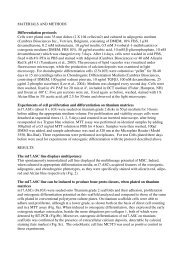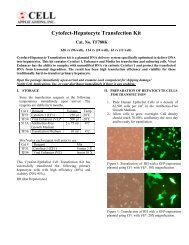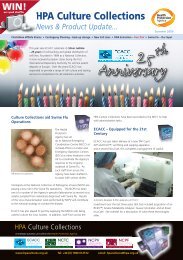Antimicrobial Resistance Reference Strains Available from NCTC
Antimicrobial Resistance Reference Strains Available from NCTC
Antimicrobial Resistance Reference Strains Available from NCTC
You also want an ePaper? Increase the reach of your titles
YUMPU automatically turns print PDFs into web optimized ePapers that Google loves.
<strong>Antimicrobial</strong> <strong>Resistance</strong><br />
<strong>Reference</strong> <strong>Strains</strong> <strong>Available</strong><br />
<strong>from</strong> <strong>NCTC</strong><br />
The Health Protection Agency’s National Collection of Type Cultures (<strong>NCTC</strong>),<br />
working in partnership with the Health Protection Agency’s <strong>Antimicrobial</strong><br />
<strong>Resistance</strong> and Healthcare Associated Infections <strong>Reference</strong> Unit (AMRHAI)<br />
offers a range of reference strains with characterised resistance mechanisms.<br />
These include:<br />
• A range of extended-spectrum b-lactamases (ESBLs), including<br />
examples of all major CTX-M groups.<br />
• A range of carbapenemases, including examples of all of the five major<br />
groups which dominate internationally, namely KPC and OXA-48 nonmetallo-enzymes<br />
and IMP, NDM and VIM metallo-carbapenemases.<br />
• The first reported clinical isolates of vancomycin-resistant enterococci<br />
(VRE) 16 .<br />
• Several fully-sequenced (and published) multi-drug resistance plasmids.<br />
• Methicillin-resistant Staphylococcus aureus (MRSA) including the first<br />
reported (and whole genome sequenced) strain identified with the<br />
novel mecA homologue, mecC.<br />
With the exception of laboratory-derived strains containing fully sequenced<br />
plasmids, most of these strains are partially-characterised and, as such, are<br />
likely to have other resistance mechanisms in addition to those specified.<br />
<strong>Strains</strong> are manufactured in accordance with the requirements of<br />
ISO 9001:2008 and undergo extensive quality control by <strong>NCTC</strong> and AMRHAI to<br />
confirm the characteristics of the strain as new batches are prepared, although<br />
plasmids and genes are not resequenced.<br />
For more information, or to order online visit www.hpacultures.org.uk<br />
The significant increase in the incidence of antibiotic resistance in bacteria<br />
observed in recent years represents a major challenge to public health microbiology<br />
worldwide. Not least among these challenges are extended-spectrum b-lactamases<br />
(ESBLs) and carbapenemases among Enterobacteriaceae and other Gram-negative<br />
micro-organisms and vancomycin resistance among enterococci.<br />
The Health Protection Agency’s <strong>Antimicrobial</strong> <strong>Resistance</strong> and Healthcare Associated<br />
Infections <strong>Reference</strong> Unit (AMRHAI) is the national reference laboratory responsible<br />
for the detection and investigation of antibiotic resistance, especially in healthcare<br />
associated bacterial pathogens, and offers molecular detection of the genetic<br />
determinants of certain key resistances.<br />
M015.20121119.v2
1. Penicillinase without Extended-Spectrum b-Lactamase (ESBL) Activity :<br />
Organism<br />
<strong>NCTC</strong>® Strain<br />
<strong>Reference</strong><br />
Escherichia coli <strong>NCTC</strong> 11560<br />
Characteristics<br />
TEM-1 b-lactamase producer. British Society of <strong>Antimicrobial</strong><br />
Chemotherapy recommended control strain<br />
Escherichia coli <strong>NCTC</strong> 11954 (ATCC 35218) b-lactamase producing control strain 2<br />
Staphylococcus aureus <strong>NCTC</strong> 11561 b-lactamase producing control strain<br />
Ref<br />
1<br />
2. Extended-Spectrum b-Lactamases (ESBL):<br />
2.1 TEM b-lactamases<br />
Organism<br />
<strong>NCTC</strong>® Strain<br />
<strong>Reference</strong><br />
Escherichia coli <strong>NCTC</strong> 13351<br />
Escherichia coli <strong>NCTC</strong> 13352<br />
Characteristics<br />
TEM-3 ESBL – Transconjugant of strain isolated in<br />
Clermont Ferrand in 1985<br />
TEM-10 ESBL – Transconjugant of original TEM-10 producer<br />
isolated in Chicago in 1988<br />
Ref<br />
1<br />
2<br />
2.2 SHV b-lactamases<br />
Organism<br />
<strong>NCTC</strong>® Strain<br />
<strong>Reference</strong><br />
Characteristics<br />
Ref<br />
Klebsiella pneumoniae <strong>NCTC</strong> 13368 SHV-18 (ATCC 700603)<br />
2.3 CTX-M b-lactamases<br />
Organism<br />
<strong>NCTC</strong>® Strain<br />
<strong>Reference</strong><br />
Escherichia coli <strong>NCTC</strong> 13353<br />
Escherichia coli <strong>NCTC</strong> 13441<br />
Characteristics<br />
Strain EO 487. CTX-M-15 ESBL producer. Control strain for group 1<br />
bla CTX-M<br />
multiplex PCR assays<br />
Strain EO 499. CTX-M-15 ESBL producer – Uropathogenic strain O25:H4<br />
sequence type (ST) 131. Clinical isolate harbouring sequenced plasmid<br />
pEK499 (see <strong>NCTC</strong> 13400);<br />
Control strain for group 1 bla CTX-M<br />
multiplex PCR assays<br />
Ref<br />
3<br />
3<br />
Escherichia coli <strong>NCTC</strong> 13400<br />
Escherichia coli <strong>NCTC</strong> 13451<br />
Strain Tr499 = DH5-a derivative. Source of pEK499 (fully sequenced<br />
plasmid GenBank Accession No EU935739) encoding CTX-M-15 enzyme.<br />
Fusion of type FII and FIA replicons, and harbours 10 antibiotic resistance<br />
genes (see catalogue entry for details)<br />
Strain J499 = J53 derivative. Source of pEK499 (fully sequenced plasmid<br />
GenBank Accession No EU935739) encoding CTX-M-15 enzyme. Fusion of<br />
type FII and FIA replicons, and harbours 10 antibiotic resistance genes (see<br />
catalogue entry for details)<br />
4<br />
4<br />
Escherichia coli <strong>NCTC</strong> 13450<br />
Strain Tr516 = DH5-a derivative. Source of pEK516 (fully sequenced plasmid<br />
GenBank Accession No EU935738), which encodes CTX-M-15 enzyme.<br />
Harbours 7 antibiotic resistance genes (see catalogue entry for details)<br />
4<br />
Escherichia coli <strong>NCTC</strong> 13452<br />
Strain J204 = J53 derivative. Source of pEK204 (fully sequenced plasmid<br />
GenBank Accession No EU935740), encoding CTX-M-3 enzyme. Plasmid<br />
pEK204 (93,732-bp) belongs to incompatibility group IncI1, and harbours<br />
two antibiotic resistance genes (see catalogue entry for details)<br />
4<br />
Escherichia coli <strong>NCTC</strong> 13461 Strain harbours unsequenced bla CTX-M<br />
group 1 gene 5<br />
Escherichia coli <strong>NCTC</strong> 13462 Strain harbours unsequenced bla CTX-M<br />
group 2 gene 5<br />
Escherichia coli <strong>NCTC</strong> 13463 Strain harbours unsequenced bla CTX-M<br />
group 8 gene 5<br />
Enterobacter cloacae <strong>NCTC</strong> 13464 Strain harbours unsequenced bla CTX-M<br />
group 9 gene 5<br />
Klebsiella pneumoniae <strong>NCTC</strong> 13465 Strain harbours unsequenced bla CTX-M<br />
group 25 gene 5<br />
2.4 VEB b-lactamases<br />
Organism<br />
<strong>NCTC</strong> ® Strain<br />
<strong>Reference</strong><br />
Characteristics<br />
Ref<br />
Pseudomonas aeruginosa <strong>NCTC</strong> 13437 VIM-10; VEB-1 6
3. AmpC b-Lactamases<br />
Organism<br />
<strong>NCTC</strong> ® Strain<br />
<strong>Reference</strong><br />
Enterobacter cloacae <strong>NCTC</strong> 13405<br />
Enterobacter cloacae <strong>NCTC</strong> 13406<br />
4. Carbapenemases<br />
Characteristics<br />
Strain 684. Inducible AmpC b-lactamase, wild type. Control for AmpC<br />
detection tests.<br />
Strain 684-con. AmpC b-lactamase de-repressed (i.e. constitutive hyperproducing)<br />
mutant of <strong>NCTC</strong> 13405. Control for AmpC detection tests<br />
Ref<br />
4.1 Class A Carbapenemase<br />
Organism<br />
<strong>NCTC</strong> ® Strain<br />
<strong>Reference</strong><br />
Klebsiella pneumoniae <strong>NCTC</strong> 13438<br />
4.2 Class B Carbapenemases (Metallo-b-lactamases):<br />
Characteristics<br />
Member of the international ST258 clone producing KPC-3<br />
carbapenemase<br />
Organism<br />
<strong>NCTC</strong> ® Strain<br />
<strong>Reference</strong><br />
Characteristics<br />
Ref<br />
Pseudomonas<br />
aeruginosa<br />
<strong>NCTC</strong> 13437 VIM-10; VEB-1 6<br />
Klebsiella pneumoniae <strong>NCTC</strong> 13439 VIM-1; QnrS1 (outbreak strain) 8<br />
Klebsiella pneumoniae <strong>NCTC</strong> 13440 VIM-1; QnrS1 (sporadic) 8<br />
Klebsiella pneumoniae <strong>NCTC</strong> 13443 New Delhi Metallo-b-lactamase (NDM-1)<br />
Escherichia coli <strong>NCTC</strong> 13476 IMP-type (unsequenced)<br />
4.3 Class D Carbapenemases (OXA carbapenemases):<br />
Organism<br />
<strong>NCTC</strong> ® Strain<br />
<strong>Reference</strong><br />
Characteristics<br />
Acinetobacter baumannii <strong>NCTC</strong> 13301 OXA-23 (also with OXA-51-like) 9<br />
Acinetobacter baumannii <strong>NCTC</strong> 13302 OXA-25 (OXA-24/40-like) (also with OXA-51-like) 9<br />
Acinetobacter baumannii <strong>NCTC</strong> 13303 OXA-26 (also with OXA-51-like) 9<br />
Acinetobacter baumannii <strong>NCTC</strong> 13304 OXA-27 (also with OXA-51-like) 9<br />
Acinetobacter baumannii <strong>NCTC</strong> 13305 (A 15) OXA-58 (also with OXA-51-like) 10<br />
Acinetobacter baumannii <strong>NCTC</strong> 13421 OXA-23 Clone 2 (also with OXA-51-like) 11,12<br />
Acinetobacter baumannii <strong>NCTC</strong> 13424 OXA-23 Clone 1 (also with OXA-51-like) 11,12<br />
Acinetobacter baumannii <strong>NCTC</strong> 13420 SE Clone OXA-51-like 11,12<br />
Acinetobacter baumannii <strong>NCTC</strong> 13422 NW Clone OXA-51-like 13, 14,15<br />
Acinetobacter baumannii <strong>NCTC</strong> 13423 T strain (UK3) OXA-51-like 13,14,15<br />
Klebsiella pneumoniae <strong>NCTC</strong> 13442 Sequence type 353 with OXA-48 17<br />
5. Plasmid-mediated Fluoroquinolone <strong>Resistance</strong> (Qnr)<br />
Organism<br />
<strong>NCTC</strong> ® Strain<br />
<strong>Reference</strong><br />
Characteristics<br />
Klebsiella pneumoniae <strong>NCTC</strong> 13439 VIM-1; QnrS1 (outbreak strain) 8<br />
Klebsiella pneumoniae <strong>NCTC</strong> 13440 VIM-1; QnrS1 (sporadic) 8<br />
Ref<br />
7<br />
Ref<br />
Ref<br />
Escherichia coli <strong>NCTC</strong> 13441<br />
Escherichia coli <strong>NCTC</strong> 13400<br />
Escherichia coli <strong>NCTC</strong> 13451<br />
Escherichia coli <strong>NCTC</strong> 13450<br />
Strain EO 499. AAC(6’)-Ib-cr producer – Uropathogenic strain O25:H4<br />
sequence type (ST) 131. Clinical isolate harbouring sequenced plasmid<br />
pEK499 (see <strong>NCTC</strong> 13400)<br />
Strain Tr499 = DH5-a derivative. Source of pEK499 (fully sequenced plasmid<br />
GenBank Accession No EU935739) encoding AAC(6’)-Ib-cr enzyme. Fusion<br />
of type FII and FIA replicons, and harbours 10 antibiotic resistance genes (see<br />
catalogue entry for details)<br />
Strain J499 = J53 derivative. Source of pEK499 (fully sequenced plasmid<br />
GenBank Accession No EU935739) encoding AAC(6’)-Ib-cr enzyme. Fusion<br />
of type FII and FIA replicons, and harbours 10 antibiotic resistance genes (see<br />
catalogue entry for details)<br />
Strain Tr516 = DH5-a derivative. Source of pEK516 (fully sequenced plasmid<br />
GenBank Accession No EU935738), which encodes AAC(6’)-Ib-cr enzyme.<br />
Harbours 7 antibiotic resistance genes (see catalogue entry for details)<br />
3<br />
4<br />
4<br />
4
Contact Details:<br />
Health Protection Agency Culture Collections<br />
Health Protection Agency<br />
Microbiology Services (Porton)<br />
Porton Down<br />
Salisbury<br />
SP4 0JG<br />
UK<br />
www.hpacultures.org.uk<br />
Enquiries<br />
Tel: +44 (0)1980 612512<br />
Fax: +44 (0)1980 611315<br />
Email: hpacultures@hpa.org.uk<br />
<strong>Antimicrobial</strong> <strong>Resistance</strong> & Healthcare Associated<br />
Infections <strong>Reference</strong> Unit (AMRHAI)<br />
Health Protection Agency<br />
Microbiology Services (Colindale)<br />
61 Colindale Avenue<br />
London NW9 5EQ<br />
Email: amrhai@hpa.org.uk<br />
Tel: +44 (0)20 8327 6511<br />
Fax: +44 (0)20 8200 7449<br />
www.hpa.org.uk<br />
6. Vancomycin Resistant Enterococci<br />
Organism<br />
<strong>NCTC</strong>® Strain<br />
<strong>Reference</strong><br />
Characteristics<br />
Ref<br />
Enterococcus faecalis <strong>NCTC</strong> 12201<br />
VanA-type glycopeptide resistance<br />
Erythromycin resistant<br />
16<br />
Enterococcus faecium <strong>NCTC</strong> 12202 VanA-type glycopeptide resistance 16<br />
Enterococcus faecalis <strong>NCTC</strong> 12203 VanA-type glycopeptide resistance 16<br />
Enterococcus faecium <strong>NCTC</strong> 12204 VanA-type glycopeptide resistance 16<br />
7. Multidrug <strong>Resistance</strong> Plasmids<br />
Organism<br />
<strong>NCTC</strong>® Strain<br />
<strong>Reference</strong><br />
Escherichia coli <strong>NCTC</strong> 13400<br />
Escherichia coli <strong>NCTC</strong> 13451<br />
Escherichia coli <strong>NCTC</strong> 13450<br />
Escherichia coli <strong>NCTC</strong> 13452<br />
Characteristics<br />
Strain Tr499 = DH5-a derivative. Source of pEK499 (fully sequenced plasmid<br />
GenBank Accession No EU935739). Fusion of type FII and FIA replicons, and<br />
harbours 10 antibiotic resistance genes (see catalogue entry for details)<br />
Strain J499 = J53 derivative. Source of pEK499 (fully sequenced plasmid GenBank<br />
Accession No EU935739). Fusion of type FII and FIA replicons, and harbours 10<br />
antibiotic resistance genes (see catalogue entry for details)<br />
Strain Tr516 = DH5-a derivative. Source of pEK516 (fully sequenced plasmid<br />
GenBank Accession No EU935738). Harbours 7 antibiotic resistance genes (see<br />
catalogue entry for details)<br />
Strain J204 = J53 derivative. Source of pEK204 (fully sequenced plasmid GenBank<br />
Accession No EU935740), encoding CTX-M-3 enzyme. Plasmid pEK204 (93,732-<br />
bp) belongs to incompatibility group IncI1, and harbours two antibiotic resistance<br />
genes (see catalogue entry for details)<br />
Ref<br />
4<br />
4<br />
4<br />
4<br />
8. Methicillin-Resistant Staphylococcus aureus (MRSA)<br />
Organism<br />
<strong>NCTC</strong>® Strain<br />
<strong>Reference</strong><br />
Staphylococcus aureus <strong>NCTC</strong> 13142<br />
Staphylococcus aureus <strong>NCTC</strong> 13552<br />
Characteristics<br />
EMRSA-15 type strain. Epidemic MRSA <strong>from</strong> UK. Control for mecA<br />
detection tests.<br />
Strain LGA251. Control for mecA homologue (soon to be assigned<br />
mecC) detection tests. Isolated <strong>from</strong> bulk milk.<br />
Ref<br />
18<br />
19<br />
<strong>Reference</strong>s<br />
1. Sirot D, Sirot J, Labia R. Transferable resistance to third generation cephalosporins in clinical isolates of Klebsiella<br />
pneumoniae. J Antimicrob Chemother. 1987;20:323-334.<br />
2. Quinn JP, Miyashiro D, Sahm D, Flamm R, Bush Kl. Novel plasmid-mediated beta-lactamase (TEM-10) conferring selective<br />
resistance to ceftazidime and axtreonam in clinical isolates of Klebsiella pneumoniae. Antimicrob Agents Chemother.<br />
1989;33(9):1451-1456.<br />
3. Woodford N, Ward ME, Kaufmann ME,Turton J, Fagan EJ, James D, Johnson AP, Pike R, Warner M,Cheasty T, Pearson A, Harry<br />
S, Leach JB, Loughrey A, Lowes JA, Warren RE, Livemore DM. Community and hospital spread of Escherichia coli producing<br />
CTX-M extended-spectrum b-lactamases in the UK. J Antimicrob Chemother. 2004;54:735-43.<br />
4. Woodford N, Carattilo A, Karisik E, Underwood A, Ellington MJ, Livermore DM. Complete nucleotide sequences of plasmids<br />
pEK204, pEK499, and pEK516, encoding CTX-M enzymes in three major Escherichia coli lineages <strong>from</strong> the United<br />
Kingdom, all belonging to the international O25:H4-ST131 clone. Antimicrob Agents Chemother. 2009;53(10):4472-4482.<br />
5. Woodford N, Fagan EJ, Ellington MJ. Multiplex PCR for rapid detection of genes encoding CTX-M extended-spectrum<br />
(beta)-lactamases. J Antimicrob Chemother. 2006;57:154-5.<br />
6. Woodford N, Zhang J, Kaufmann ME, Yarde S, Tomas Mdel M, Faris C, Vardhan MS, Dawson S, Cotterill SL, Livermore DM.<br />
Detection of Pseudomonas aeruginosa isolates producing VEB-type extended-spectrum beta-lactamases in the United<br />
Kingdom. J Antimicrob Chemother. 2008;62(6):1265-8.<br />
7. Woodford N, Zhang J, Warner M, Kaufmann ME, Matos J, Macdonald A, Brudney D, Sompolinsky D, Navon-Venezia S,<br />
Livermore DM. Arrival of Klebsiella pneumoniae producing KPC carbapenemase in the United Kingdom. J Antimicrob<br />
Chemother. 2008;62(6):1261-4.<br />
8. Aschbacher R, Doumith M, Livermore DM, Larcher C, Woodford N. Linkage of acquired quinolone resistance (qnrS1) and<br />
metallo-beta-lactamase (blaVIM-1) genes in multiple species of Enterobacteriaceae <strong>from</strong> Bolzano, Italy. J Antimicrob<br />
Chemother. 2008;61(3):515-23.<br />
9. Afzal-Shah M, Woodford N, Livermore DM. Characterization of OXA-25, OXA-26, and OXA-27, molecular class D betalactamases<br />
associated with carbapenem resistance in clinical isolates of Acinetobacter baumannii. Antimicrob Agents<br />
Chemother. 2001;45(2):583-8.<br />
10. Coelho J, Woodford N, Afzal-Shah M, Livermore D. Occurrence of OXA-58-like carbapenemases in Acinetobacter spp.<br />
collected over 10 years in three continents. Antimicrob Agents Chemother. 2006;50(2):756-8.<br />
11. Turton JF, Kaufmann ME, Warner M, Coelho J, Dijkshoorn L, van der Reijden T, Pitt TL. A prevalent, multiresistant clone of<br />
Acinetobacter baumannii in Southeast England. J Hosp Infect. 2004;58(3):170-9.<br />
12. Coelho JM, Turton JF, Kaufmann ME, Glover J, Woodford N, Warner M, Palepou MF, Pike R, Pitt TL, Patel BC, Livermore DM.<br />
Occurrence of carbapenem-resistant Acinetobacter baumannii clones at multiple hospitals in London and Southeast<br />
England. J Clin Microbiol. 2006;44(10):3623-7.<br />
13. Turton JF, Kaufmann ME, Glover J, Coelho JM, Warner M, Pike R, Pitt TL. Detection and typing of integrons in epidemic<br />
strains of Acinetobacter baumannii found in the United Kingdom. J Clin Microbiol. 2005;43(7):3074-82.<br />
14. Turton JF, Kaufmann ME, Gill MJ, Pike R, Scott PT, Fishbain J, Craft D, Deye G, Riddell S, Lindler LE, Pitt TL. Comparison of<br />
Acinetobacter baumannii isolates <strong>from</strong> the United Kingdom and the United States that were associated with repatriated<br />
casualties of the Iraq conflict. J Clin Microbiol. 2006;44(7):2630-4.<br />
15. Turton JF, Gabriel SN, Valderrey C, Kaufmann ME, Pitt TL. Use of sequence-based typing and multiplex PCR to identify clonal<br />
lineages of outbreak strains of Acinetobacter baumannii. Clin Microbiol Infect. 2007;13(8):807-15.<br />
16. Uttley AHC, George RC, Naidoo J, Woodford N, Johnson AP, Collins CH, Morrison D, Gilfillan AJ, Fitch,LE, Heptonstall J. High<br />
level Vancomycin-resistant Enterococci causing hospital infections. Epidem Inf. 1989;103:173-181.<br />
17. Dimou V, Dhanji H, Pike R, Livermore DM, Woodford N. Characterization of Enterobacteriaceae producing OXA-48-like<br />
carbapenemases in the UK. J Antimicrob Chemother. 2012;67(7):1660-5.<br />
18. O’Neill GL, Murchan S, Gil-Setas A, Aucken HM. Identification and characterization of phage variants of a strain of epidemic<br />
methicillin-resistant Staphylococcus aureus (EMRSA-15). J Clin Microbiol. 2001;39:1540-8.<br />
19. García-Álvarez L, Holden MTG, Lindsay H, Webb CR, Brown DFJ, Curran MD, Walpole E, Brooks K, Pickard DJ, Teale C, Parkhill<br />
J, Bentley SD, Edwards GF, Girvan EK, Kearns AM, Pichon B, Hill R, Larsen AR, Skov RL, Peacock SJ, Maskell DJ, Holmes MA.<br />
Meticillin-resistant Staphylococcus aureus with a novel mecA homologue in human and bovine populations in the UK and<br />
Denmark: a descriptive study. Lancet Infect Dis. 2011;11(8):595-603.







